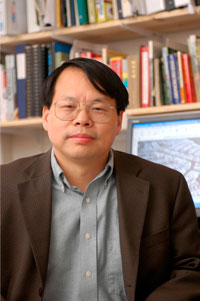AgBioResearch scientist says 'telecoupling' explains why it's a small (and fast) world, after all
Understanding and managing how humans and nature sustainably coexist is now so sweeping and occurring so lightning fast that it's spawned a concept. Meet "telecoupling."
 Understanding and managing how humans and nature sustainably coexist is now so sweeping and occurring so lightning fast that it's spawned a concept. Meet "telecoupling."
Understanding and managing how humans and nature sustainably coexist is now so sweeping and occurring so lightning fast that it's spawned a concept. Meet "telecoupling."
Joining its popular cousins telecommuting and television, telecoupling is the way Jack Liu, AgBioResearch scientist and director of the Human-Nature Lab/Center for Systems Integration and Sustainability at Michigan State University, is describing how distance is shrinking and connections are strengthening between nature and humans.
The "Telecoupling of Human and Natural Systems" symposium was held at this year's annual meeting of the American Association for the Advancement of Science.
"This is a beginning of exploring the new frontier," said Liu, who also holds the Rachel Carson Chair in Sustainability at MSU. "Telecoupling is about connecting both human and natural systems across boundaries. There are new and faster ways of connecting the whole planet – from big events such as earthquakes and floods to tourism, trade, migration, pollution, climate change, flows of information and financial capital, and invasion of animal and plant species."
Liu said that telecoupling is a way to express one of the often overwhelming consequences of globalization – the way an event or phenomenon in one corner of the world can have an impact far away. In effect, systems couple, connecting across space and time.
Increased trade, expanding transportation networks, the Internet, invasive species – all have made everything seem closer. That has enormous consequences for environmental and socioeconomic sustainability.
Thomas Baerwald, National Science Foundation (NSF) program director, observes that traditional analyses in the natural and social sciences presumed that many phenomena were predominantly the product of local conditions and processes.
"While local factors remain significant," Baerwald said, "the researchers participating in this symposium highlighted ways in which geographic scales of interaction have changed significantly in recent decades. NSF and the research community now are exploring these new dynamics in order to enhance basic understanding and consider ways to enhance the lives of people and the environment we inhabit."
In addition to Liu, other presenters at this symposium were:
- Ruth DeFries, Columbia University.
- Eric F. Lambin, University of Louvain, Belgium, and Stanford University.
- William D. Nordhaus, Yale University.
- Peter Raven, Missouri Botanical Garden.
- Peter Gleick, Pacific Institute for Studies in Development, Environment, and Security.



 Print
Print Email
Email
